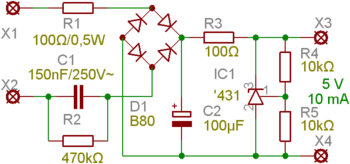Capacitive power supply
A capacitive power supply, also called a capacitive dropper, is a type of power supply that uses the capacitive reactance of a capacitor to reduce the mains voltage to a lower voltage. There are two important limitations: First, the high withstanding voltage required of the capacitor, along with the high-capacitance required for a given output current, mean that this type of supply is only practical for low-power applications. (The capacitance needed increases with the current to be drawn; high capacitance mains-voltage capacitors are expensive and bulky.) The second is that due to the absence of electrical isolation between input and output, anything connected to the power supply must be reliably insulated so that it is not possible for a person to come into electrical contact with it.[1][2] By the equation of state for capacitance, where , the current is limited to: 1 amp, per farad, per volt-rms, per radian (of phase). Or amps, per farad, per volt-rms, per hertz.

Structure
A capacitive power supply usually has a rectifier and filter to generate a direct current from the reduced alternating voltage.
Such a supply comprises a capacitor, C1 whose reactance limits the current flowing through the rectifier bridge D1. A resistor, R1, connected in series with it protects against voltage spikes during switching operations. An electrolytic capacitor, C2, is used to smooth the DC voltage and the peak current (in the range of amps) in switching operations. Above right a voltage regulator can be seen, formed by the current limiting resistor, R3, and the zener shunt regulator, IC1. If the voltage stability is not too important a Zener diode can be used as a regulator; the two-terminal device would eliminate R4 and R5 used as a resistive voltage divider in the schematic above.
Example

By changing the value of the example in the diagram by a capacitor with a value of 330 nF, we can provide a current of 20 mA. This way you can power up to 48 white LEDs (for example, 3.1 V/20 mA/20000 mcd) - that is provided connected in series. At 50 Hz, the 1.2 μF capacitor has a reactance of 2.653 kohm. By Ohm's law, the current is limited to 240 V/2653 Ω = 90 mA, assuming that voltage and frequency remain constant.
LEDs are connected in parallel with the 10 μF electrolytic filter capacitor. The four branches with 12 LEDs consume about 20 mA each. The diodes limit the voltage to about 40 V per branch. Since, normally, the circuit is connected directly to the network without galvanic isolation, we need a residual-current circuit breaker in any type of protection circuit used for this kind of LED light.
References
External links
| Wikimedia Commons has media related to Capacitive power supply. |